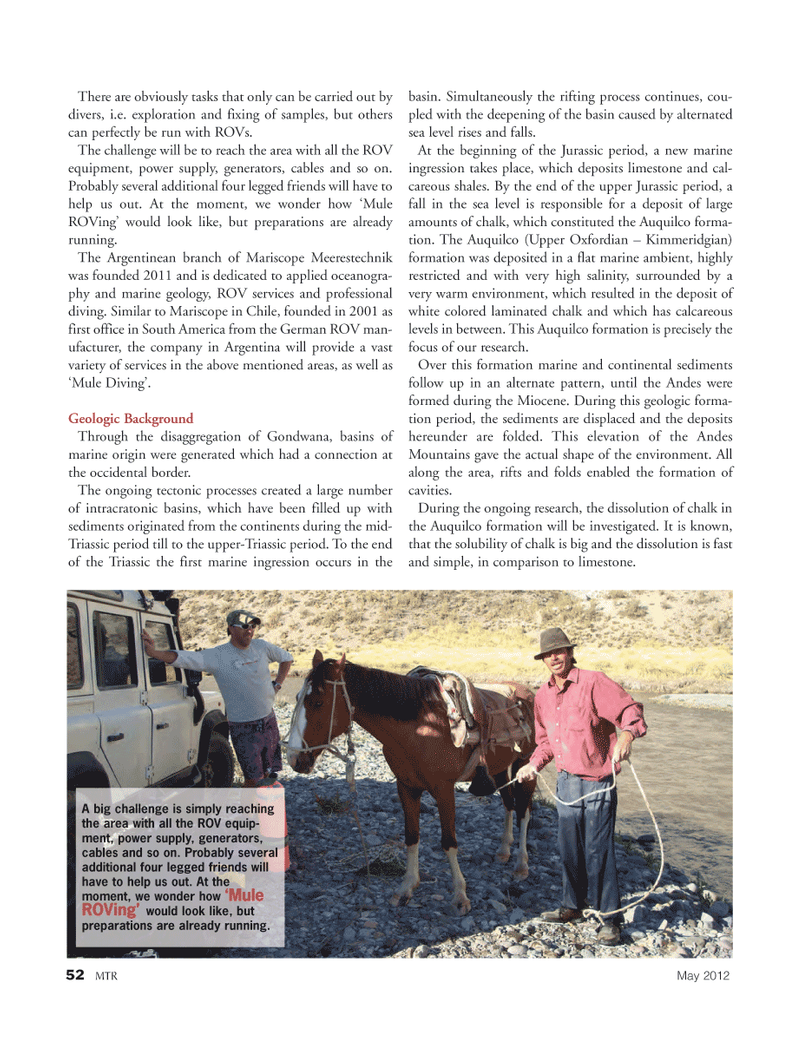
Page 52: of Marine Technology Magazine (May 2012)
Hydrographic Survey
Read this page in Pdf, Flash or Html5 edition of May 2012 Marine Technology Magazine
52MTRMay 2012There are obviously tasks that only can be carried out by divers, i.e. exploration and fixing of samples, but others can perfectly be run with ROVs. The challenge will be to reach the area with all the ROV equipment, power supply, generators, cables and so on. Probably several additional four legged friends will have to help us out. At the moment, we wonder how ?Mule ROVing? would look like, but preparations are already running. The Argentinean branch of Mariscope Meerestechnik was founded 2011 and is dedicated to applied oceanogra-phy and marine geology, ROV services and professional diving. Similar to Mariscope in Chile, founded in 2001 as first office in South America from the German ROV man- ufacturer, the company in Argentina will provide a vast variety of services in the above mentioned areas, as well as ?Mule Diving?. Geologic Background Through the disaggregation of Gondwana, basins of marine origin were generated which had a connection at the occidental border. The ongoing tectonic processes created a large number of intracratonic basins, which have been filled up with sediments originated from the continents during the mid- Triassic period till to the upper-Triassic period. To the end of the Triassic the first marine ingression occurs in the basin. Simultaneously the rifting process continues, cou- pled with the deepening of the basin caused by alternated sea level rises and falls. At the beginning of the Jurassic period, a new marine ingression takes place, which deposits limestone and cal- careous shales. By the end of the upper Jurassic period, a fall in the sea level is responsible for a deposit of large amounts of chalk, which constituted the Auquilco forma- tion. The Auquilco (Upper Oxfordian ? Kimmeridgian) formation was deposited in a flat marine ambient, highlyrestricted and with very high salinity, surrounded by a very warm environment, which resulted in the deposit of white colored laminated chalk and which has calcareous levels in between. This Auquilco formation is precisely the focus of our research. Over this formation marine and continental sediments follow up in an alternate pattern, until the Andes were formed during the Miocene. During this geologic forma- tion period, the sediments are displaced and the deposits hereunder are folded. This elevation of the Andes Mountains gave the actual shape of the environment. All along the area, rifts and folds enabled the formation of cavities.During the ongoing research, the dissolution of chalk in the Auquilco formation will be investigated. It is known, that the solubility of chalk is big and the dissolution is fastand simple, in comparison to limestone.A big challenge is simply reaching the area with all the ROV equip- ment, power supply, generators, cables and so on. Probably several additional four legged friends willhave to help us out. At themoment, we wonder how ?MuleROVing? would look like, butpreparations are already running. MTR#4 (50-64):MTR Layouts 5/4/2012 3:16 PM Page 52

 51
51

 53
53
